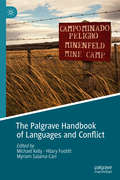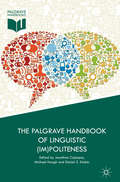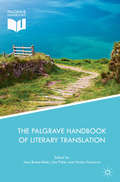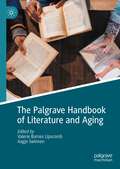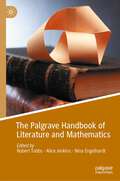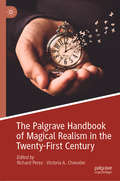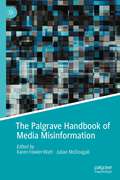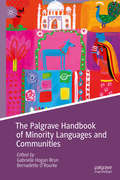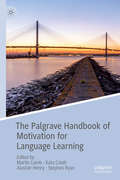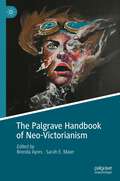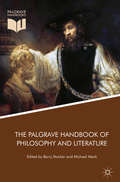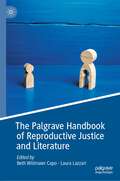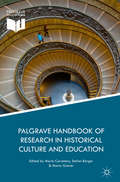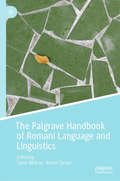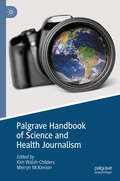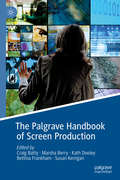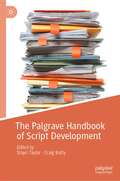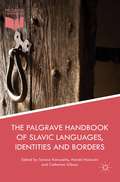- Table View
- List View
The Palgrave Handbook of Language and Crisis Communication in Sub-Saharan Africa
by Hugh Mangeya Isaac Mhute Ernest JakazaThis handbook provides a detailed and sustained examination of the scope, purpose and practical application of crisis and disaster management communication in this critical region of the African continent, sub-Saharan Africa (SSA). The volume lays the foundation that enables a nuanced appreciation of two significant issues. The first pertains to SSA’s vulnerability to both natural and man-made phenomena. Secondly, it argues that communication plays a critical role in so far as the identification, social construction, raising awareness, preparation, mitigation and eradication of crises and disasters in the region. Communication plays a critical role in potentially reducing the impacts of crises and disasters before their occurrence. This handbook is a key resource for academics, students and practitioners in areas such as political communication, media communication, language and communication, brand communication, social/digital media communication, and crisis communication, among others.
The Palgrave Handbook of Language Policies in Africa
by Esther Mukewa Lisanza Leonard MuakaThis handbook explores language policies and their impacts in Africa, examining the different language policies in each country from pre-colonial to post-colonial times. Most African countries are multilingual, apart from a handful which are said to be quasi-monolingual. The authors in this handbook investigate language policy in education, media, legal courts, government documents and other public domains, and show how these policies shape learning and delivery of services to the citizens. The volume also pays special attention to the roles assigned to minority languages in Africa, most of which are endangered. The contributions also investigate how these language policies are influenced by the history of colonialism and language attitudes emanating from colonial rule. This handbook will be of interest to a diverse audience of readers, including those interested in African languages, language planning and policy, and African history and education.
The Palgrave Handbook of Languages and Conflict
by Michael Kelly Hilary Footitt Myriam Salama-CarrThis Handbook maps the contours of an exciting and burgeoning interdisciplinary field concerned with the role of language and languages in situations of conflict. It explores conceptual approaches, sources of information that are available, and the institutions and actors that mediate language encounters. It examines case studies of the role that languages have played in specific conflicts, from colonial times through to the Middle East and Africa today. The contributors provide vibrant evidence to challenge the monolingual assumptions that have affected traditional views of war and conflict. They show that languages are woven into every aspect of the making of war and peace, and demonstrate how language shapes public policy and military strategy, setting frameworks and expectations. The Handbook's 22 chapters powerfully illustrate how the encounter between languages is integral to almost all conflicts, to every phase of military operations and to the lived experiences of those on the ground, who meet, work and fight with speakers of other languages. This comprehensive work will appeal to scholars from across the disciplines of linguistics, translation studies, history, and international relations; and provide fresh insights for a broad range of practitioners interested in understanding the role and implications of foreign languages in war.
The Palgrave Handbook of Linguistic (Im)politeness
by Jonathan Culpeper Dániel Z. Kádár Michael HaughThis handbook comprehensively examines social interaction by providing a critical overview of the field of linguistic politeness and impoliteness. Authored by over forty leading scholars, it offers a diverse and multidisciplinary approach to a vast array of themes that are vital to the study of interpersonal communication. The chapters explore the use of (im)politeness in specific contexts as well as wider developments, and variations across cultures and contexts in understandings of key concepts (such as power, emotion, identity and ideology). Within each chapter, the authors select a topic and offer a critical commentary on the key linguistic concepts associated with it, supporting their assertions with case studies that enable the reader to consider the practicalities of (im)politeness studies. This volume will be of interest to students and scholars of linguistics, particularly those concerned with pragmatics, sociolinguistics and interpersonal communication. Its multidisciplinary nature means that it is also relevant to researchers across the social sciences and humanities, particularly those working in sociology, psychology and history.
The Palgrave Handbook of Literary Translation (Palgrave Studies in Translating and Interpreting)
by Jean Boase-Beier Lina Fisher Hiroko FurukawaThis Handbook offers a comprehensive and engaging overview of contemporary issues in Literary Translation research through in-depth investigations of actual case studies of particular works, authors or translators. Leading researchers from across the globe discuss best practice, problems, and possibilities in the translation of poetry, novels, memoir and theatre. Divided into three sections, these illuminating analyses also address broad themes including translation style, the author-translator-reader relationship, and relationships between national identity and literary translation. The case studies are drawn from languages and language varieties, such as Catalan, Chinese, Dutch, English, French, German, Hebrew, Italian, Japanese, Nigerian English, Russian, Spanish, Scottish English and Turkish. The editors provide thorough introductory and concluding chapters, which highlight the value of case study research, and explore in detail the importance of the theory-practice link. Covering a wide range of topics, perspectives, methods, languages and geographies, this handbook will provide a valuable resource for researchers not only in Translation Studies, but also in the related fields of Linguistics, Languages and Cultural Studies, Stylistics, Comparative Literature or Literary Studies.
The Palgrave Handbook of Literary Translation (Palgrave Studies in Translating and Interpreting)
by Jean Boase-Beier Lina Fisher Hiroko FurukawaThis Handbook offers a comprehensive and engaging overview of contemporary issues in Literary Translation research through in-depth investigations of actual case studies of particular works, authors or translators. Leading researchers from across the globe discuss best practice, problems, and possibilities in the translation of poetry, novels, memoir and theatre. Divided into three sections, these illuminating analyses also address broad themes including translation style, the author-translator-reader relationship, and relationships between national identity and literary translation. The case studies are drawn from languages and language varieties, such as Catalan, Chinese, Dutch, English, French, German, Hebrew, Italian, Japanese, Nigerian English, Russian, Spanish, Scottish English and Turkish. The editors provide thorough introductory and concluding chapters, which highlight the value of case study research, and explore in detail the importance of the theory-practice link. Covering a wide range of topics, perspectives, methods, languages and geographies, this handbook will provide a valuable resource for researchers not only in Translation Studies, but also in the related fields of Linguistics, Languages and Cultural Studies, Stylistics, Comparative Literature or Literary Studies.
The Palgrave Handbook of Literature and Aging
by Valerie Barnes Lipscomb Aagje SwinnenThis handbook offers a comprehensive survey of the growing field of literary age studies and points to new directions in scholarly research. Divided into four sections, the volume reflects the current conversations in the field: intersections and intersectionalities, traveling concepts, methodological innovations, and archival inquiries. It encompasses the spectrum of critical approaches that literary age studies scholars employ, from environmental studies and postcolonial theory to critical race theory and queer studies. While close reading continues to be a mainstay of literary criticism, the handbook highlights alternative tools and routes in both data elicitation and analysis. The final part of the book shows the burgeoning interest in the field from literary scholars across historical periods, extending the scope of literary age studies beyond contemporary texts. This is an essential reference work for advanced students and scholars of literary studies, gerontology, age/aging studies, interdisciplinary studies and cultural studies.
The Palgrave Handbook of Literature and Mathematics
by Nina Engelhardt Alice Jenkins Robert TubbsThis handbook features essays written by both literary scholars and mathematicians that examine multiple facets of the connections between literature and mathematics. These connections range from mathematics and poetic meter to mathematics and modernism to mathematics as literature. Some chapters focus on a single author, such as mathematics and Ezra Pound, Gertrude Stein, or Charles Dickens, while others consider a mathematical topic common to two or more authors, such as squaring the circle, chaos theory, Newton’s calculus, or stochastic processes. With appeal for scholars and students in literature, mathematics, cultural history, and history of mathematics, this important volume aims to introduce the range, fertility, and complexity of the connections between mathematics, literature, and literary theory.
The Palgrave Handbook of Literature and the City
by Jeremy TamblingThis book is about the impact of literature upon cities world-wide, and cities upon literature. It examines why the city matters so much to contemporary critical theory, and why it has inspired so many forms of writing which have attempted to deal with its challenges to think about it and to represent it. Gathering together 40 contributors who look at different modes of writing and film-making in throughout the world, this handbook asks how the modern city has engendered so much theoretical consideration, and looks at cities and their literature from China to Peru, from New York to Paris, from London to Kinshasa. It looks at some of the ways in which modern cities – whether capitals, shanty-towns, industrial or ‘rust-belt’ – have forced themselves on people’s ways of thinking and writing.
The Palgrave Handbook of Magical Realism in the Twenty-First Century
by Richard Perez Victoria A. ChevalierThe Palgrave Handbook of Magical Realism in the Twenty-First Century examines magical realism in literatures from around the globe. Featuring twenty-seven essays written by leading scholars, this anthology argues that literary expressions of magical realism proliferate globally in the twenty-first century due to travel and migrations, the shrinking of time and space, and the growing encroachment of human life on nature. In this global context, magical realism addresses twenty-first-century politics, aesthetics, identity, and social/national formations where contact between and within cultures has exponentially increased, altering how communities and nations imagine themselves. This text assembles a group of critics throughout the world—the Americas, Europe, Africa, Asia, the Middle East, and Australia—who employ multiple theoretical approaches to examine the different ways magical realism in literature has transitioned to a global practice; thus, signaling a new stage in the history and development of the genre.
The Palgrave Handbook of Media Misinformation
by Karen Fowler-Watt Julian McDougallThe Palgrave Handbook of Media Misinformation provides a comprehensive and cutting-edge resource on the critical debates surrounding fake news and misinformation online. Spanning all continents and linking academic, journalistic, and educational communities, this collection offers authoritative coverage of conspiracy theories, the post-Trump and Brexit landscape, and the role of big tech in threats to democracy and free speech. The collection moves through a diagnosis of misinformation and its impacts on democracy and civic societies, the 'mainstreaming' of conspiracy theory, the impacts of misinformation on health and science, and the increasing significance of data visualization. Following these diagnoses, the handbook moves to responses from two communities of practice – the world of journalism and the field of media literacy.
The Palgrave Handbook of Minority Languages and Communities
by Gabrielle Hogan-Brun Bernadette O’RourkeThis Handbook is an in-depth appraisal of the field of minority languages and communities today. It presents a wide-ranging, coherent picture of the main topics, with key contributions from international specialists in sociolinguistics, policy studies, sociology, anthropology and law. Individual chapters are grouped together in themes, covering regional, non-territorial and migratory language settings across the world. It is the essential reference work for specialist researchers, scholars in ancillary disciplines, research and coursework students, public agencies and anyone interested in language diversity, multilingualism and migration.
The Palgrave Handbook of Motivation for Language Learning
by Kata Csizér Stephen Ryan Alastair Henry Martin LambThis handbook offers an authoritative, one-stop reference work for the dynamic and expanding field of language learning motivation. The 32 chapters have been specially commissioned from the field’s most influential researchers and writers. Together they present a compelling picture of the motivations people have for learning languages, the diverse ways we can research motivation, and the implications for promoting and sustaining learners’ motivation. The first section outlines the main theoretical approaches to language learning motivation; the next section presents ways in which motivation theory has been applied in practice; the third section showcases examples of motivation research in particular contexts and with particular types of language learners; and the final section describes the exciting directions that contemporary research is taking, promising important new insights for academics and practitioners alike.
The Palgrave Handbook of Multilingualism and Language Varieties on Screen
by Irene Ranzato Patrick ZabalbeascoaThis handbook brings together contributions from the main experts in the field of multilingualism and language varieties (including dialects, accents, sociolects, and idiolects of specific speech communities) as expressed in fictional dialogue on-screen in films, and television series. The chapters included in the volume cover both the representation of these varieties and multilingual situations on screen as well as their translation into a range of languages. The handbook will thus be an essential resource for scholars and students in diverse fields including translation studies, audiovisual translation, linguistics, dialectology, film and television studies.
The Palgrave Handbook of Neo-Victorianism
by Brenda Ayres Sarah E. MaierThis handbook offers analysis of diverse genres and media of neo-Victorianism, including film and television adaptations of Victorian texts, authors’ life stories, graphic novels, and contemporary fiction set in the nineteenth century. Contextualized by Sarah E Maier and Brenda Ayres in a comprehensive introduction, the collection describes current trends in neo-Victorian scholarship of novels, film, theatre, crime, empire/postcolonialism, Gothic, materiality, religion and science, amongst others. A variety of scholars from around the world contribute to this volume by applying an assortment of theoretical approaches and interdisciplinary focus in their critique of a wide range of narratives—from early neo-Victorian texts such as A. S. Byatt’s Possession (1963) and Jean Rhys’ Wide Sargasso Sea (1966) to recent steampunk, from musical theatre to slumming, and from The Alienist to queerness—in their investigation of how this fiction reconstructs the past, informed by and reinforming the present.
The Palgrave Handbook of Philosophy and Literature
by Barry Stocker Michael MackThis comprehensive Handbook presents the major perspectives within philosophy and literary studies on the relations, overlaps and tensions between philosophy and literature. Drawing on recent work in philosophy and literature, literary theory, philosophical aesthetics, literature as philosophy and philosophy as literature, its twenty-nine chapters plus substantial Introduction and Afterword examine the ways in which philosophy and literature depend on each other and interact, while also contrasting with each other in that they necessarily exclude or incorporate each other. This book establishes an enduring framework for structuring the broad themes defining the relations between philosophy and literature and organising the main topics in the field.Key Features• Structured in five parts addressing philosophy as literature, philosophy of literature, philosophical aesthetics, literary criticism and theory, and main areas of work within philosophy and literature• An Introduction setting out the main concerns of the field through discussion of the major themes along with the individual topics• An Afterword looking at the interactions between philosophy and literature through itself enacting philosophical and literary writing while examining the question of how they can be brought togetherThe Palgrave Handbook of Philosophy and Literature is an essential resource for scholars, researchers and advanced students in philosophy of literature, philosophy as literature, literary theory, literature as philosophy, and the philosophical aesthetics of literature. It is an ideal volume for researchers, advanced students and scholars in philosophy, literary studies, philosophy and literature, cultural studies, classical studies and other related fields.
The Palgrave Handbook of Reproductive Justice and Literature
by Beth Widmaier Capo Laura LazzariThis handbook offers a collection of scholarly essays that analyze questions of reproductive justice throughout its cultural representation in global literature and film. It offers analysis of specific texts carefully situated in their evolving historical, economic, and cultural contexts. Reproductive justice is taken beyond the American setting in which the theory and movement began; chapters apply concepts to international realities and literatures from different countries and cultures by covering diverse genres of cultural production, including film, television, YouTube documentaries, drama, short story, novel, memoir, and self-help literature. Each chapter analyzes texts from within the framework of reproductive justice in an interdisciplinary way, including English, Japanese, Italian, Spanish, and German language, literature and culture, comparative literature, film, South Asian fiction, Canadian theatre, writing, gender studies, Deaf studies, disability studies, global health and medical humanities, and sociology. Academics, graduate students and advanced undergraduate students in Literature, Gender, Sexuality and Women’s Studies, Cultural Studies, Motherhood Studies, Comparative Literature, History, Sociology, the Medical Humanities, Reproductive Justice, and Human Rights are the main audience of the volume.
Palgrave Handbook of Research in Historical Culture and Education
by Stefan Berger Maria Grever Mario CarreteroThis volume comprises a broad interdisciplinary examination of the many different approaches by which contemporary scholars record our history. The editors provide a comprehensive overview through thirty-eight chapters divided into four parts: a) Historical Culture and Public Uses of History; b) The Appeal of the Nation in History Education of Postcolonial Societies; c) Reflections on History Learning and Teaching; d) Educational Resources: Curricula, Textbooks and New Media. This unique text integrates contributions of researchers from history, education, collective memory, museum studies, heritage, social and cognitive psychology, and other social sciences, stimulating an interdisciplinary dialogue. Contributors come from various countries of Northern and Southern America, Europe and Asia, providing an international perspective that does justice to the complexity of this field of study. The Palgrave Handbook of Research in Historical Culture and Education provides state-of-the-art research, focussing on how citizens and societies make sense of the past through different ways of representing it.
The Palgrave Handbook of Romani Language and Linguistics
by Yaron Matras Anton TenserRomani is the first language, and family and community language, of upwards of 3-4 million people and possibly many more in Europe, the Americas, and Australia. Documentation and research on the language draws on a tradition of more than two centuries, yet it remains relatively unknown and often engulfed by myths. In recent decades there has been an upsurge of interest in the language including language maintenance and educational projects, the creation of digital resources, language policy initiatives, and a flourishing community of online users of the language. This Handbook presents state of the art research on Romani language and linguistics. Bringing together key established scholars in the field of linguistics and neighbouring disciplines, it introduces the reader to the structures of Romani and its dialect divisions, and to the history of research on the language. It then goes on to explore major external influences on the language through contact with other key languages, aspects of language acquisition, and interventions in support of the language through public policy provisions, activism, translation, religious and literary initiatives, and social media. This comprehensive and groundbreaking account of Romani will appeal to students and scholars from across language and linguistics.
Palgrave Handbook of Science and Health Journalism
by Kim Walsh-Childers Merryn McKinnonThis handbook reviews the extant literature on the most important issues in health and science journalism, with a focus on summarizing the relevant research and identifying key questions that are yet to be answered. It explores challenges and best practices in health and science reporting, formats and audiences, key topics such as climate change, pandemics and space science, and the ethics and political impacts of science and health journalist practice. With numerous international contributions, it provides a comprehensive overview of an emerging area of journalism studies and science communication.
The Palgrave Handbook of Screen Production
by Craig Batty Marsha Berry Susan Kerrigan Kath Dooley Bettina FrankhamThis handbook is an essential creative, critical and practical guide for students and educators of screen production internationally. It covers all aspects of screen production—from conceptualizing ideas and developing them, to realizing and then distributing them—across all forms and formats, including fiction and non-fiction for cinema, television, gallery spaces and the web. With chapters by practitioners, scholars and educators from around the world, the book provides a comprehensive collection of approaches for those studying and teaching the development and production of screen content. With college and university students in mind, the volume purposely combines theory and practice to offer a critically informed and intellectually rich guide to screen production, shaped by the needs of those working in education environments where ‘doing’ and ‘thinking’ must co-exist. The Palgrave Handbook of Screen Production fills an important gap in creative-critical knowledge of screen production, while also providing practical tools and approaches for future practitioners.
The Palgrave Handbook of Screenwriting Studies
by Rosamund Davies Paolo Russo Claus TieberThis book provides an overview of the growing field of screenwriting research and is essential reading for both those new to the field and established screenwriting scholars. It covers topics and concepts central to the study of screenwriting and the screenplay in relation to film, television, web series, animation, games and other interactive media, and includes a range of approaches, from theoretical perspectives to in-depth case studies. 44 scholars from around the globe demonstrate the range and depths of this new and expanding area of study. As the chapters of this Handbook demonstrate, shifting the focus from the finished film to the process of screenwriting and the text of the screenplay facilitates valuable new insights. This Handbook is the first of its kind, an indispensable compendium for both academics and practitioners.
The Palgrave Handbook of Script Development
by Craig Batty Stayci TaylorThe Palgrave Handbook of Script Development provides the first comprehensive overview of international script development practices. Across 40 unique chapters, readers are guided through the key challenges, roles and cultures of script development, from the perspectives of creators of original works, those in consultative roles and those giving broader contextual case studies. The authors take us inside the writers’ room, alongside the script editor, between development conversations, and outside the mainstream and into the experimental. With authors spanning upwards of 15 countries, and occupying an array of roles – including writer, script editor, producer, script consultant, executive, teacher and scholar, this is a truly international perspective on how script development functions (or otherwise) across media and platforms. Comprising four parts, the handbook guides readers behind the scenes of script development, exploring unique contexts, alternative approaches, specific production cultures and global contexts, drawing on interviews, archives, policy, case study research and the insider track. With its broad approach to a specialised practice, the Palgrave Handbook of Script Development is for anyone who practices, teaches or studies screenwriting and screen production.
The Palgrave Handbook of Slavic Languages, Identities and Borders
by Tomasz Kamusella Motoki Nomachi Catherine GibsonThis book analyzes the creation of languages across the Slavophone areas of the world and their deployment for political projects and identity building, mainly after 1989. It offers perspectives from a number of disciplines such as sociolinguistics, socio-political history and language policy.Languages are artefacts of culture, meaning they are created by people. They are often used for identity building and maintenance, but in Central and Eastern Europe they became the basis of nation building and national statehood maintenance. The recent split of the Serbo-Croatian language in the wake of the break-up of Yugoslavia amply illustrates the highly politicized role of languages in this region, which is also home to most of the world’s Slavic-speakers. This volume presents and analyzes the creation of languages across the Slavophone areas of the world and their deployment for political projects and identity building, mainly after 1989. The overview concludes with a reflection on the recent rise of Slavophone speech communities in Western Europe and Israel. The book brings together renowned international scholars who offer a variety of perspectives from a number of disciplines and sub-fields such as sociolinguistics, socio-political history and language policy, making this book of great interest to historians, sociologists, political scientists and anthropologists interested in Central and Eastern Europe and Slavic Studies.
The Palgrave Handbook of Testimony and Culture
by Sara Jones Roger WoodsThis Palgrave Handbook examines the ways in which researchers and practitioners theorise, analyse, produce and make use of testimony. It explores the full range of testimony in the public sphere, including perpetrator testimony, testimony presented through social media and virtual reality. A growing body of research shows how complex and multi-layered testimony can be, how much this complexity adds to our understanding of our past, and how creators and users of testimony have their own complex purposes. These advances indicate that many of our existing assumptions about testimony and models for working with it need to be revisited. The purpose of this Palgrave Handbook is to do just that by bringing together a wide range of disciplinary, theoretical, methodological, and practice-based perspectives.


